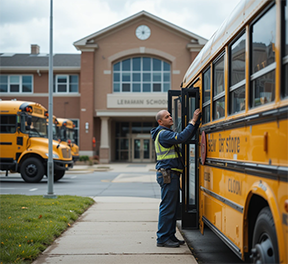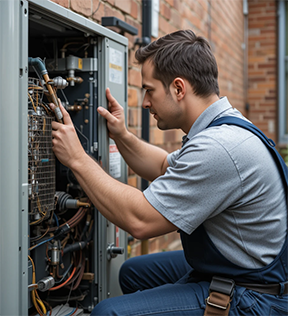Published: March 25, 2014 | Updated: September 15, 2025
Published: March 25, 2014 | Updated: September 15, 2025
13 Critical Reasons School Districts Must Implement Maintenance Software
 A simple search for "school equipment failures" yields a stark and concerning reality: inadequate maintenance management systems significantly impact the efficacy and safety of our public education system. The sheer volume and diversity of problems schools face daily range from minor inconveniences to potentially catastrophic events. This discussion shows thirteen critical reasons school districts must implement maintenance software.
A simple search for "school equipment failures" yields a stark and concerning reality: inadequate maintenance management systems significantly impact the efficacy and safety of our public education system. The sheer volume and diversity of problems schools face daily range from minor inconveniences to potentially catastrophic events. This discussion shows thirteen critical reasons school districts must implement maintenance software.
Why Schools Require Robust Maintenance Software
The imperative for a computerized maintenance management system (CMMS) in educational settings is paramount. Schools, with their complex infrastructure, diverse equipment, and high traffic, benefit immensely from structured and proactive maintenance practices.
The sheer scope of responsibilities, from ensuring heating and cooling systems operate efficiently to maintaining the safety of playground equipment, necessitates a systematic approach. Let's delve into the core reasons why these systems are not just beneficial, but essential for modern educational institutions.
Prioritizing Safety: A Non-Negotiable Imperative
Safety stands as the most critical and non-negotiable reason for implementing a CMMS in schools. Equipment malfunctions can lead to severe injuries, and in tragic instances, fatalities. The potential for accidents involving faulty electrical systems, malfunctioning HVAC units, or deteriorating structural components is a constant concern.
A proactive maintenance system mitigates these risks by ensuring equipment operates reliably and within safety parameters. It also provides clear guidance on proper equipment usage and emergency response protocols, empowering staff to act decisively in critical situations. The ability to schedule regular inspections and maintenance tasks, coupled with automated alerts for potential issues, ensures that safety remains a top priority.
Consider instances like the boy injured on faulty school playground equipment or the school bus accident blamed on poor maintenance. These cases underscore the dire consequences of neglecting maintenance and highlight the importance of preventative measures. A well-maintained environment fosters a sense of security, allowing students to focus on learning and staff to perform their duties without undue worry.
Mitigating Liability Through Diligent Maintenance
The potential for safety hazards from poorly maintained equipment exposes schools to significant liability. Legal repercussions from accidents or injuries can financially devastate and damage the institution's reputation. Consistent and effective maintenance practices, facilitated by a CMMS, minimize the risk of injuries.
Implementing a CMMS facilitates meticulous record-keeping and proactive maintenance, demonstrating due diligence and protecting the institution. Detailed logs of inspections, repairs, and maintenance tasks provide crucial evidence in the event of an incident.
Discover how streamlined maintenance processes can elevate production. Learn more.
Preventing Disruptive Downtime: Maintaining Educational Continuity
Equipment failures lead to downtime, which is particularly disruptive in a school environment. Unlike a typical business, schools must manage the impact on hundreds or thousands of students. Imagine a school without air conditioning during a heatwave, lighting in classrooms, or functioning technology for digital learning. Issues like power outages, false fire alarms, or even radiation monitor failures can disrupt the educational process, leading to lost learning time and increased stress for students and staff.
Boiler failures are a common cause of school closures, particularly in colder climates. An example like the Nelson Place School boiler incident highlight the severity of this issue.
Regular boiler maintenance, facilitated by a CMMS, prevents such disruptions, ensuring that schools remain open and operational throughout the academic year. A well-functioning heating system is not just a matter of comfort; it's a critical component of a conducive learning environment.
Ensuring a Clean and Safe Learning Environment
School facilities naturally accumulate wear and tear, and the high volume of traffic exacerbates this. Issues like chipped paint, broken doors, and damaged windows require constant attention. Neglecting these problems leads to further deterioration and potential safety hazards. A cracked window, if ignored, can become a broken window, leading to water damage and mold growth, posing health risks to students and staff.
Similarly, slow drainage in school sewers can escalate to serious sewage issues, creating unsanitary conditions. A CMMS enables systematic tracking and resolution of these maintenance needs, ensuring that the school environment remains clean, safe, and conducive to learning. Regular inspections and timely repairs are crucial for maintaining a positive and healthy atmosphere.
Effective Asset Tracking: Maximizing Resource Utilization
Schools manage a vast inventory of equipment, from computers in labs to specialized teaching tools and athletic equipment. Accurate asset tracking is essential for budget management and efficient maintenance scheduling. A CMMS provides a centralized database for inventory management, ensuring that schools don't overspend on redundant equipment and can readily schedule necessary maintenance. Detailed records of each asset, including purchase dates, warranty information, and maintenance history, enable schools to make informed decisions about repairs and replacements.
Maintaining Fiscal Responsibility: Staying Within Budget
A CMMS helps schools adhere to their budgets by preventing costly equipment breakdowns and optimizing resource allocation. By tracking assets and scheduling preventative maintenance, schools avoid unexpected expenses and extend the lifespan of their equipment. p>
Achieving Compliance: Adhering to Regulatory Standards
Schools must comply with various safety and regulatory standards, including fire safety, building codes, and accessibility requirements. A CMMS aids in compliance management by storing relevant documentation and ensuring that all necessary procedures are followed.
This system tracks all compliance steps to reduce the risk of penalties and legal issues. Supervisors can schedule regular audits and document inspections to demonstrate the school's commitment to compliance.
Centralized User Manuals: Empowering Staff
Access to equipment user manuals gives technicians an advantage on troubleshooting. A CMMS provides a central repository for these manuals. You can input the relevant information for each asset.
Warranty Management: Saving Time and Money
Storing warranty information within a CMMS allows schools to leverage cost-saving warranties for equipment repairs and replacements. Again, you can attach the necessary documentation to the asset record. This eliminates the need for time-consuming searches through physical files.
The CMMS stores the history of maintenance—work orders, maintenance activities, and follow-ups. This keeps the staff and the department accountable. You have the history of parts used. The system keeps a history of revisions to work orders and asset records.< p>
Efficient Work Order Scheduling: Proactive Maintenance
A core function of maintenance software is the ability to schedule and manage work orders, both for routine maintenance and urgent repairs. Look for a system that offers a scheduling calendar.
Create your list of preventive maintenance tasks, assign specific inventory, and attach the PM to an asset. Later, you can convert a PM into a general work order, assign a specific labor resource, and schedule it.
 Enhancing Energy Efficiency: Reducing Utility Costs
Enhancing Energy Efficiency: Reducing Utility Costs
Regular maintenance improves equipment efficiency, reducing energy consumption and utility costs. A CMMS helps identify and address inefficiencies, contributing to environmental sustainability and cost savings.
For example, a well-maintained HVAC system consumes less energy, reducing the school's carbon footprint and lowering utility bills. Tracking energy consumption patterns through the CMMS allows for better oversight regarding equipment upgrades and maintenance schedules.
Cost Reduction: Protecting Educational Programs
Ultimately, a CMMS helps schools reduce operational costs. By preventing equipment failures, optimizing resource allocation, and enhancing efficiency, schools can protect essential educational programs and staffing levels. In an era of budget constraints, this is more critical than ever. The savings generated from reduced maintenance costs and improved efficiency can be reinvested into educational resources. Implementing a CMMS is not just about maintaining equipment; it's about investing in the future of education.
CMMS: Grade A Software for Schools
In conclusion, the adoption of maintenance software by school districts brings a multitude of benefits. From enhanced safety and reduced liability to improved efficiency and cost savings, underscores the importance of these systems. By implementing a quality CMMS, schools can ensure a safe, efficient, and conducive learning environment for all students and staff. The proactive approach to maintenance facilitated by these systems allows schools to focus on their core mission: providing quality education.
FAQs
What is a CMMS and why is it important for schools?
A CMMS, or computerized maintenance management system, helps schools manage equipment, safety, and facilities to reduce downtime and costs.
How does maintenance software improve school safety?
It ensures regular inspections and proactive repairs to prevent accidents and equipment failures.
Can CMMS software help schools save money?
Yes, by extending equipment lifespan, reducing unexpected breakdowns, and keeping maintenance within budget.
Why should schools consider MAPCON’s CMMS?
MAPCON offers user-friendly tools for scheduling, asset tracking, and compliance, designed to fit educational institutions.
How does a CMMS help schools stay compliant with regulations?
It tracks inspections, stores documentation, and ensures adherence to safety and building codes.
Does CMMS improve energy efficiency in schools?
Yes, regular maintenance improves HVAC and other systems, lowering energy costs and supporting sustainability.
MAPCON | 800-922-4336
MAPCON CMMS software empowers you to plan and execute PM tasks flawlessly, thanks to its wealth of features and customizable options. Want to see it for yourself? Click the button below to get your FREE 30-day trial of MAPCON!
Try It FREE!